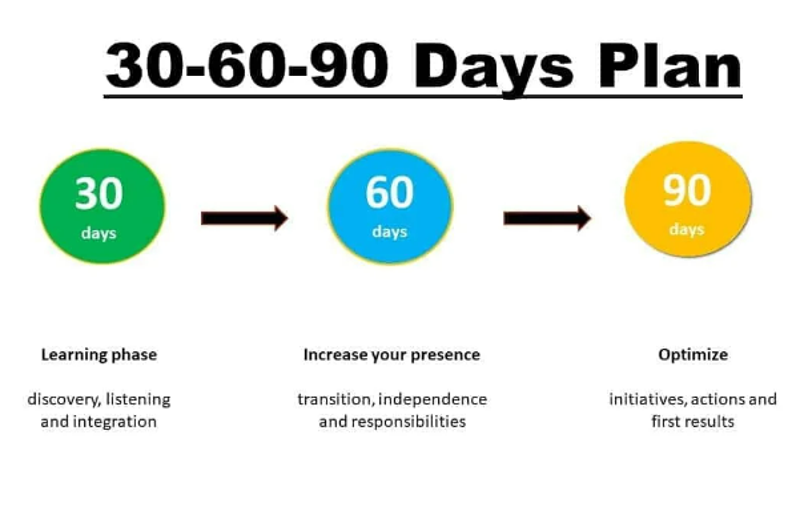Stepping into a new program manager role or any new role can be both exciting and daunting. To ensure a smooth transition and set yourself up for success, creating a detailed 30-60-90 day plan is essential. This plan not only helps you prioritize your efforts but also demonstrates your proactive approach to your new team and leadership.
Why a 30-60-90 Day Plan?
A 30-60-90 day plan outlines your goals and actions for the first three months in your new role. It helps you:
- Build a strong foundation: Understand the organization's culture, processes, and expectations.
- Identify key projects and stakeholders: Establish relationships and begin contributing effectively.
- Measure progress and adapt: Regularly assess your achievements and adjust your approach as needed.

The 30-Day Plan: Laying the Groundwork
Goals:
-
Understand the Organization:
- Familiarize yourself with the company's mission, vision, and values.
- Review the organizational structure and meet key team members.
-
Learn the Processes:
- Study existing program management processes and methodologies.
- Understand the tools and software used for project tracking and communication.
-
Build Relationships:
- Schedule introductory meetings with team members, stakeholders, and leadership.
- Attend team meetings and observe dynamics and workflows.
Actions:
- Onboarding: Complete any formal onboarding processes, including HR training and systems access.
- Documentation Review: Go through company handbooks, project documents, and any relevant materials to get up to speed.
- Shadowing: Observe current projects and program activities to understand ongoing efforts and challenges.
Deliverables:
- A comprehensive onboarding report summarizing key insights about the organization.
- A list of critical documents reviewed with notes on important findings.
- A stakeholder map identifying key team members and their roles.
Metrics:
- Number of key documents reviewed and understood.
- Meetings scheduled and conducted with team members and stakeholders.
- Initial understanding of organizational processes and tools.
The 60-Day Plan: Taking Initiative
Goals:
-
Assess Current Programs:
- Evaluate ongoing projects and programs for status, risks, and performance.
- Identify any immediate areas for improvement or support.
-
Develop a Strategic Plan:
- Outline short-term and long-term goals for your programs.
- Define key performance indicators (KPIs) and success metrics.
-
Foster Collaboration:
- Strengthen relationships with cross-functional teams and stakeholders.
- Establish regular communication channels and meeting cadences.
Actions:
- Program Audit: Conduct a thorough review of active projects, including timelines, budgets, and resource allocations.
- Stakeholder Analysis: Map out key stakeholders and their expectations, and plan how to manage these relationships effectively.
- Quick Wins: Identify and execute on quick wins to build credibility and momentum.
Deliverables:
- A detailed program audit report highlighting the status, risks, and opportunities within current projects.
- A stakeholder management plan with strategies for effective communication and engagement.
- An initial strategic plan draft, including defined KPIs and success metrics.
Metrics:
- Completion of program audits and stakeholder analysis.
- Strategic plan drafted and reviewed with leadership.
- Number of quick wins identified and achieved.
The 90-Day Plan: Driving Results
Goals:
-
Implement Improvements:
- Start executing the strategic plan and implementing process improvements.
- Monitor project performance and make data-driven adjustments.
-
Enhance Team Performance:
- Provide guidance and support to your team to enhance their productivity and engagement.
- Identify any skill gaps and recommend training or development opportunities.
-
Communicate Progress:
- Regularly report on program status, achievements, and any issues to leadership.
- Collect feedback and continuously refine your approach.
Actions:
- Process Optimization: Introduce any new tools or processes identified during the first 60 days.
- Performance Reviews: Conduct initial performance reviews with your team to provide feedback and set expectations.
- Regular Updates: Establish a cadence for reporting progress and sharing updates with stakeholders.
Deliverables:
- An implemented process improvement plan showing changes and anticipated benefits.
- Performance review summaries with actionable feedback for each team member.
- A progress report template for regular updates to stakeholders and leadership.
Metrics:
- Successful implementation of new processes or tools.
- Positive feedback from team performance reviews.
- Regular progress reports delivered to leadership and stakeholders.
Conclusion
A well-crafted 30-60-90 day plan is instrumental in ensuring a successful transition into a new program manager role. By setting clear goals, taking strategic actions, and regularly measuring your progress, you can build a solid foundation, drive meaningful improvements, and establish yourself as a valuable leader within your organization. Embrace this structured approach, and you'll be well on your way to achieving long-term success in your new role. I have included a sample 30-60-90 plan for a Program Manager role.
#ProgramManagement #306090DayPlan #NewRoleSuccess #LeadershipOnboarding #StrategicPlanning #StakeholderEngagement #ProjectManagement #TeamIntegration #PerformanceMetrics #AgileLeadership #CareerDevelopment #First90Days #ProfessionalGrowth #OnboardingStrategy #ProgramManagerTips #ManagingProjectsTheAgileWay
Download PDF or Presentation
New Example Presentation
Download New Example PDF or Presentation
Author: Kimberly Wiethoff